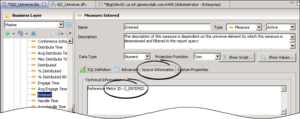Measure Names
Use the information on this page to understand measure naming and reference metric IDs.
Reference Metric ID
Many classes contain measures with names that match measures in other classes. However, the full name of a measure includes the class in which the measure belongs, which thereby makes it unique. Because the full name can be quite long, most measures have been assigned a reference metric ID which appears on the Source Information tab of the measure’s properties. This ID is informational only and is not referenced by any of the reports. Should you need to contact Genesys Customer Care for assistance, this ID might be useful when you are describing a particular measure.
The figure Reference Metric ID of the Queue\Entered Measure shows the ID that is assigned to the Entered measure that belongs to the Q Customer class in GI2_Universe. By contrast, the reference ID of the like-named measure in the BA Customer class is T_ENTERED.
Naming Convention
Detail measures are sourced from the following Genesys Info Mart tables:
- SM_RES_STATE_FACT
- SM_RES_STATE_REASON_FACT
- MEDIATION_SEGMENT_FACT
- INTERACTION_RESOURCE_FACT
All interval measures are sourced from aggregation tables that contain "_I_" in the database object name—for example:
- AG2_I_AGENT_SUBHR
- AG2_I_STATE_RSN_SUBHR
- AG2_I_SESS_STATE_SUBHR
No special naming convention identifies a table as one that contains disposition measures, other than disposition measures are all sourced from AG2_* tables that do not to use "_I_" in the table name—for instance:
- AG2_AGENT_CAMPAIGN_HOUR
- AG2_AGENT_QUEUE_HOUR
- AG2_CAMPAIGN_HOUR
- AG2_QUEUE_HOUR
- AG2_QUEUE_ABN_HOUR
- AG2_QUEUE_ACC_AGENT_HOUR
- AG2_QUEUE_GRP_HOUR
- AG2_ID_HOUR
- AG2_AGENT_HOUR
- AG2_AGENT_GRP_HOUR
Each hierarchy contains seven tables and/or views, which have the following suffixes: _SUBHR, _HOUR, _DAY, _WEEK, _MONTH, _QRTR, and _YEAR.

